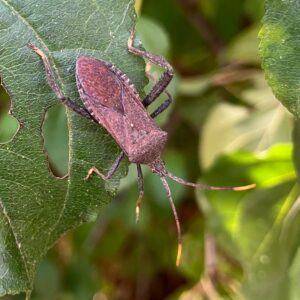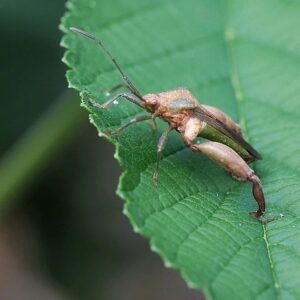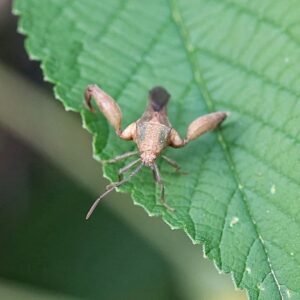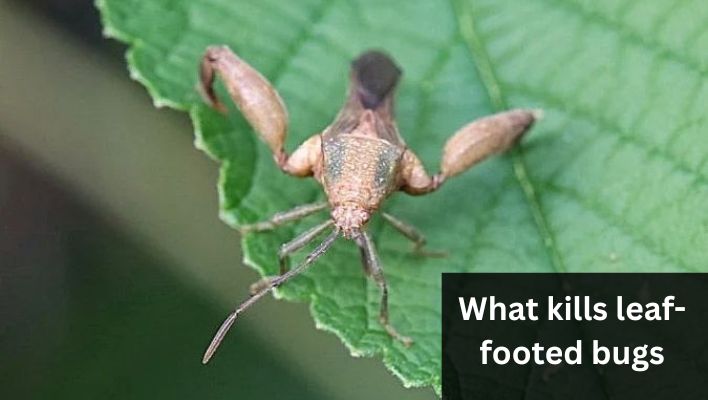Leaf-footed bugs, with their unique leaf-shaped hind legs, may seem harmless at first glance, but these tiny insects can wreak havoc on your plants and crops. If you’ve ever noticed wilting leaves, stunted growth, or deformed fruits, chances are leaf-footed bugs are to blame. This article will explore what kills leaf-footed bugs and discover effective strategies to control their populations.
Controlling leaf-footed bugs is of paramount importance to safeguard the health and productivity of your garden or crops. These pests have a voracious appetite for plant sap, and their piercing-sucking mouthparts can cause extensive damage.
By taking proactive measures to combat leaf-footed bugs, you’ll not only protect your plants but also ensure bountiful harvests and flourishing green spaces.
Below, we’ll delve into various methods, both natural and chemical, to address the leaf-footed bug menace. So, let’s roll up our sleeves and arm ourselves with the knowledge and tools needed to defend against these pesky invaders. Together, we’ll reclaim our gardens and crops from the clutches of leaf-footed bugs. Let’s get started
Identifying Leaf-Footed Bugs
To effectively combat leaf-footed bugs, it’s crucial to be able to identify them accurately. Let’s take a closer look at their description and physical characteristics, as well as the telltale signs of a leaf-footed bug infestation.
Description and Physical Characteristics:
Leaf-footed bugs (Coreidae family) are medium-sized insects, typically measuring around three-quarters to one inch in length. Their elongated bodies can vary in color, ranging from brown to green, often blending with their surroundings.
However, their most distinctive feature is their hind legs, which resemble leaves or flattened extensions. This unique adaptation helps them camouflage among the foliage, making them harder to spot.

Common Signs of Leaf-Footed Bug Infestation:
Detecting a leaf-footed bug infestation early can save your plants from significant damage. Look out for these common signs:
- Yellowing Leaves: As leaf-footed bugs pierce the plant tissues and suck out the sap, leaves may turn yellow, indicating their presence.
- Wilting Plants: Infested plants often exhibit wilting, even with sufficient water. The sustained feeding by leaf-footed bugs weakens the plants, causing them to droop.
- Deformed Fruits: If you notice misshapen or distorted fruits on your plants, leaf-footed bugs may be the culprits. Their feeding can interfere with proper fruit development.
- Foul Odor: When disturbed or crushed, leaf-footed bugs emit a distinct odor. If you encounter a foul smell while inspecting your plants, it could be an indication of their presence.
By familiarizing yourself with the physical characteristics of leaf-footed bugs and staying vigilant for signs of infestation, you’ll be better equipped to take prompt action and prevent further damage. So, keep a keen eye out for these sneaky garden invaders
Why Control Leaf-Footed Bugs?
Leaf-footed bugs may be small in size, but the damage they inflict on plants and crops can be significant. Let’s explore the reasons why controlling leaf-footed bugs is crucial for safeguarding your green spaces and ensuring healthy agricultural yields.
Damage Caused by Leaf-Footed Bugs to Plants and Crops:
Leaf-footed bugs have piercing-sucking mouthparts that allow them to feed on plant sap. As they puncture the plant tissues, they introduce toxins and withdraw vital nutrients, leading to various detrimental effects:
- Wilting and Stunted Growth: The sustained feeding by leaf-footed bugs weakens plants, causing them to wilt and experience stunted growth. This hampers their overall health and vigor.
- Deformed Fruits and Vegetables: When leaf-footed bugs attack developing fruits and vegetables, they can cause deformities and malformations. This diminishes the market value and quality of the produce.
- Reduced Photosynthesis: By targeting leaves and stems, leaf-footed bugs disrupt the photosynthetic process. This impedes the plants’ ability to produce energy, resulting in diminished vitality.
- Secondary Infections: The wounds created by leaf-footed bugs serve as entry points for pathogens and diseases, increasing the risk of secondary infections. This can further weaken plants and make them susceptible to additional damage.

Impact on Garden:
In agricultural settings, leaf-footed bugs pose a significant threat to crop yields. Large populations of these pests can cause substantial losses:
- Reduced Crop Productivity: Intense leaf-footed bug infestations can lead to a decline in crop productivity, affecting both quantity and quality. This can result in financial losses for farmers and compromised food supplies.
- Marketability Challenges: Deformed or damaged fruits and vegetables are less marketable and may fail to meet the stringent quality standards demanded by consumers and retailers.
By understanding the destructive potential of leaf-footed bugs and their impact on plant health and agricultural yields, it becomes evident why proactive control measures are crucial. Let’s explore effective strategies to combat these pests and minimize their detrimental effects.
Natural Predators of Leaf-Footed Bugs
In the battle against leaf-footed bugs, nature has provided us with a formidable arsenal of natural predators. These beneficial insects play a vital role in controlling leaf-footed bug populations. Let’s explore the significance of natural predators and discover some of the key allies in this fight.
The Role of Natural Predators:
Natural predators are essential for maintaining ecological balance and regulating pest populations. When it comes to leaf-footed bugs, they serve as natural biocontrol agents, keeping their numbers in check without the need for human intervention.
By promoting and preserving a diverse ecosystem, we can encourage the presence of these helpful creatures in our gardens and agricultural landscapes.

Natural Predators of Leaf-Footed Bugs:
Several beneficial insects actively prey on leaf-footed bugs, helping to control their populations. Here are some notable natural predators:
- Assassin Bugs: Assassin bugs are voracious hunters known for their stealthy tactics. They possess sharp mouthparts that they use to pierce and feed on leaf-footed bugs and other pests. These beneficial insects can be valuable allies in your quest for leaf-footed bug control.
- Lacewings: Lacewings are delicate yet formidable predators. The larvae of lacewings, commonly called aphid lions, have a strong appetite for soft-bodied pests like leaf-footed bugs. Encouraging lacewings in your garden can provide an effective means of pest management.
- Parasitic Wasps: Certain species of parasitic wasps lay their eggs inside leaf-footed bug eggs or nymphs. When the wasp larvae hatch, they consume the host from within, effectively eliminating the leaf-footed bugs before they reach adulthood. These tiny wasps play a vital role in keeping leaf-footed bug populations under control.
- Birds: Certain bird species, including sparrows, wrens, and swallows, actively feed on insects, including leaf-footed bugs. By providing suitable bird habitats and food sources, such as birdhouses, birdbaths, and native plants that attract insects, you can encourage these feathered allies to frequent your garden.
Encouraging a Diverse Ecosystem:
To attract and sustain natural predators, it’s important to create a diverse and welcoming ecosystem in your garden. Here’s how:
- Plant Nectar-Rich Flowers: Flowers such as marigolds, cosmos, and zinnias provide nectar, attracting beneficial insects like lacewings and parasitic wasps. By incorporating these flowering plants, you can enhance the habitat for these natural predators.
- Avoid Pesticide Overuse: Excessive pesticide use can harm both pest insects and their natural predators. Minimizing pesticide applications allows beneficial insects to thrive and maintain a balanced ecosystem.
- Provide Suitable Habitats: Beneficial insects require suitable habitats for shelter, reproduction, and overwintering. Incorporate native plants, shrubs, and flowering herbs that serve as habitats and refuges for natural predators.
By creating an environment that supports natural predators, you’ll establish a sustainable and self-regulating system for controlling leaf-footed bugs. Let nature’s allies work alongside you in your mission to protect your plants from these garden intruders.
Cultural and Preventive Practices
Adopting cultural and preventive practices can be instrumental in deterring infestations and reducing their impact on your plants. Let’s explore some effective strategies to incorporate into your gardening routine and create an environment that discourages leaf-footed bugs.
Proper Plant Maintenance:
Regular maintenance of your plants is crucial in preventing leaf-footed bug infestations. Here are some key practices to follow:
- Pruning and Trimming: Prune and trim your plants regularly to remove dense foliage and overcrowded areas. This improves air circulation and sunlight penetration, making the environment less favorable for leaf-footed bugs.
- Remove Debris: Clear away fallen leaves, plant debris, and weeds regularly. These can serve as hiding places and breeding grounds for leaf-footed bugs. Dispose of the debris properly to eliminate potential habitats for these pests.
Clean Garden Environment:
Maintaining a clean garden environment is vital for discouraging leaf-footed bugs and minimizing their presence. Here’s why it’s important:
- Remove Overripe Fruits: Harvest ripe fruits promptly and remove any overripe or damaged fruits from the plants. These can attract leaf-footed bugs and serve as a food source, allowing their populations to thrive.
- Weed Control: Keep your garden free from weeds, as they can provide shelter and alternative hosts for leaf-footed bugs. Regular weeding prevents these pests from establishing themselves in your garden.
- Crop Rotation: Rotate your crops annually to disrupt the life cycle of leaf-footed bugs and other pests. This practice helps reduce the buildup of pest populations and minimizes the risk of infestations.

Integrated Pest Management (IPM):
Implementing an Integrated Pest Management approach is crucial for long-term leaf-footed bug control. IPM involves combining various strategies, including cultural practices, biological control, and targeted use of pesticides when necessary.
By integrating multiple methods, you create a holistic approach to managing leaf-footed bugs while minimizing environmental impact.
Remember, prevention is key. By adopting these cultural and preventive practices, you create an environment that is less appealing to leaf-footed bugs. Maintaining a clean and well-maintained garden not only helps deter these pests but also promotes overall plant health and vitality. Stay proactive and diligent in implementing these practices to keep your garden thriving and free from leaf-footed bug infestations.
Non-Chemical Control Methods
When it comes to combating leaf-footed bugs, non-chemical control methods can be highly effective and environmentally friendly. Let’s explore some hands-on techniques that you can implement to manage leaf-footed bug populations without relying on chemical pesticides.
Handpicking:
Handpicking is a simple yet effective method for removing leaf-footed bugs from your plants. Here’s a step-by-step guide:
- Equip yourself with gloves and a container filled with soapy water.
- Inspect your plants, focusing on the undersides of leaves, stems, and fruits.
- When you spot a leaf-footed bug, carefully pick it up and drop it into the soapy water.
- Repeat this process regularly, especially in the early morning or late evening when the bugs are more active.
Handpicking can significantly reduce leaf-footed bug populations, particularly for smaller gardens or localized infestations.
Trapping:
Traps can be an effective way to capture and control leaf-footed bugs. Here’s how you can create a simple homemade trap:
- Take a shallow container, such as a pie dish or a tray.
- Fill the container with water and add a small amount of dish soap.
- Place the container near the infested plants, ensuring it’s easily accessible for the bugs.
- Optionally, you can add a floating object, like a small piece of wood or cardboard, for the bugs to land on.
Leaf-footed bugs will be attracted to the water and soap solution, causing them to drown. Regularly check and empty the trap, especially in the mornings and evenings when the bugs are most active.
Sticky Barriers:
Sticky barriers can be used to prevent leaf-footed bugs from reaching your plants. Here’s how to create and utilize them:
- Obtain a sticky substance, such as adhesive tape or sticky traps available at garden supply stores.
- Wrap the sticky substance around the lower parts of plant stems or create strips to place around the perimeter of the garden.
- Ensure the sticky surface is facing outward and easily accessible for the bugs.
- Monitor the barriers regularly, replacing them when they become full or lose their stickiness.
Sticky barriers act as a physical deterrent, trapping the leaf-footed bugs as they attempt to crawl up the plants or enter the garden.
By implementing these non-chemical control methods, you can actively reduce leaf-footed bug populations while minimizing the use of synthetic pesticides.
Incorporate these techniques into your pest management routine and adjust the intensity based on the severity of infestations.
A hands-on approach coupled with other preventive practices can go a long way in keeping leaf-footed bugs at bay and preserving the health of your plants.
Organic Insecticides
When natural and preventive methods are not sufficient in managing leaf-footed bugs, organic insecticides can be a viable option.
These products are derived from natural sources and pose fewer risks to the environment and beneficial insects.
Let’s explore some of the best organic insecticides for controlling leaf-footed bugs, along with guidelines for their proper application and safety precautions.
Neem Oil:
Neem oil, derived from the neem tree (Azadirachta indica), is an effective organic insecticide. It works by disrupting the feeding and reproductive capabilities of leaf-footed bugs. Here’s how to use it:
- Dilute cold-pressed neem oil according to the instructions on the product label.
- Fill a spray bottle with the diluted neem oil solution.
- Spray the solution directly on the affected plants, ensuring thorough coverage of leaves, stems, and fruits.
- Apply neem oil in the early morning or late evening to avoid sunburn on the plants.
- Repeat the application every 7-14 days or as directed on the product label.

Pyrethrin-based Insecticides:
Pyrethrin-based insecticides, derived from the flowers of certain chrysanthemum species, are effective against leaf-footed bugs. They work by disrupting the nervous system of the pests. Follow these guidelines for proper application:
- Read and follow the instructions provided on the product label for dilution and application rates.
- Mix the insecticide according to the recommended concentration.
- Use a sprayer to apply the solution, covering all parts of the affected plants.
- Ensure that you apply the insecticide when leaf-footed bugs are active, typically in the early morning or late evening.
- Repeat the application as necessary, based on the severity of the infestation and the instructions on the product label.
Safety Precautions:
While organic insecticides are generally safer than their synthetic counterparts, it’s essential to follow safety precautions:
- Wear protective clothing, including gloves, long sleeves, and goggles, when handling and applying insecticides.
- Keep children and pets away from treated areas until the spray has dried.
- Store organic insecticides in their original containers, away from food, and out of reach of children.
- Dispose of empty containers and unused insecticides properly, following local guidelines.
Always refer to the product labels for specific instructions and safety information regarding the organic insecticide you choose. It’s important to use these products responsibly and judiciously to minimize any potential risks and ensure effective control of leaf-footed bugs.
Remember, organic insecticides should be considered as a supplemental method in conjunction with other preventive practices and natural control methods. By integrating these approaches, you can effectively manage leaf-footed bugs while prioritizing the health of your plants and the environment.

Chemical Control Options
In situations where natural, cultural, and organic control methods have proven insufficient, chemical insecticides can be considered a last resort for managing leaf-footed bugs.
However, it’s crucial to exercise caution and follow label instructions and precautions to minimize potential risks. Chemical control should be approached with care due to its potential environmental impact.
Here are some chemical insecticides commonly used to target leaf-footed bugs:
Pyrethroids:
Pyrethroid-based insecticides, such as bifenthrin, cypermethrin, and lambda-cyhalothrin, are commonly used to control leaf-footed bugs. These synthetic chemicals disrupt the nervous system of pests. When using pyrethroids:
- Read and carefully follow the instructions provided on the product label regarding dilution rates, application methods, and safety precautions.
- Apply the insecticide according to the recommended timing and frequency.
- Ensure that you target the affected plants, focusing on the areas where leaf-footed bugs are present.
- Avoid spraying during windy conditions to minimize drift and potential harm to beneficial insects and other non-target organisms.
Insecticidal Soaps:
Insecticidal soaps, such as potassium salts of fatty acids, can also be effective against leaf-footed bugs. These soaps disrupt the cell membranes of pests. When using insecticidal soaps:
- Follow the instructions on the product label regarding dilution rates and application methods.
- Thoroughly cover the affected plants with the soapy solution, ensuring contact with leaf-footed bugs.
- Apply the soap solution when leaf-footed bugs are active, typically in the early morning or late evening.
- Avoid excessive application or overdosing, as it may harm plants and other beneficial insects.
Systemic Insecticides:
Systemic insecticides, such as imidacloprid and dinotefuran, are absorbed by the plant and transported throughout its tissues. They provide longer-lasting control against leaf-footed bugs. When using systemic insecticides:
- Carefully read and adhere to the instructions and precautions provided by the manufacturer.
- Apply the systemic insecticide as a drench or as directed on the label to ensure proper uptake by the plant.
- Avoid applying systemic insecticides to blooming plants, as they may harm pollinators.
- Follow the recommended waiting period before harvesting any edible crops treated with systemic insecticides.
Importance of Following Label Instructions and Precautions:
When using chemical insecticides, it is essential to carefully read and adhere to the instructions and precautions provided on the product labels.
These labels provide important information on proper usage, application rates, protective equipment, and safety precautions. Adhering to label instructions helps minimize potential risks to human health, the environment, and non-target organisms.
Chemical Control as a Last Resort:
It’s important to remember that chemical control methods should be considered as a last resort for leaf-footed bug management due to their potential environmental impact.
Chemical insecticides can harm beneficial insects, pollinators, and other organisms that contribute to a balanced ecosystem.
Before resorting to chemical control, exhaust all other non-chemical and organic options and consider the potential consequences to the environment.
When using chemical control, it is crucial to use these products responsibly, sparingly, and strictly following the label instructions.o Integrated pest management (IPM) practices that combine multiple control strategies offer a more sustainable and environmentally friendly approach to managing leaf-footed bugs while minimizing reliance on chemical insecticides.

FAQs
When is the best time to treat leaf-footed bugs?
The best time to treat leaf-footed bugs is when their populations are actively present and causing significant damage to your plants. Typically, this occurs during the warmer months when the bugs are most active, such as spring and early summer. Regular monitoring of your plants will help you determine the appropriate timing for treatment.
Will using insecticides to kill leaf-footed bugs harm beneficial insects?
Yes, some insecticides, especially broad-spectrum ones, can harm beneficial insects, including pollinators and natural predators. It’s important to choose insecticides selectively and use them judiciously. Whenever possible, opt for non-chemical and organic control methods to minimize the impact on beneficial insects that help maintain a balanced ecosystem.
Can I eat fruits or vegetables treated with insecticides to kill leaf-footed bugs?
It’s important to read the product label of the insecticide used and follow the specific instructions regarding the waiting period before harvest. In some cases, systemic insecticides may require a waiting period to ensure the chemical residues have dissipated to safe levels. Always adhere to the recommended waiting period and wash your fruits and vegetables thoroughly before consumption.
How long do chemical insecticides remain effective against leaf-footed bugs?
The effectiveness of chemical insecticides varies depending on factors such as the specific product used, the severity of the infestation, and environmental conditions. Follow the instructions on the product label regarding reapplication intervals. In some cases, multiple applications may be necessary to achieve long-term control. Regular monitoring of your plants is essential to assess the need for reapplication.
Conclusion
Leaf-footed bugs can be a formidable challenge for gardeners and farmers alike, but with the right strategies, you can effectively manage their populations and protect your plants.
Throughout this article, we have explored various methods to control leaf-footed bugs, ranging from preventive practices and natural predators to non-chemical and chemical options.
Chemical control methods should be approached as a last resort due to their potential environmental consequences. If you decide to use chemical insecticides, select targeted options and apply them judiciously, following the recommended application rates and safety precautions.
Always prioritize the safety of children, pets, and beneficial insects by taking necessary precautions and adhering to waiting periods before consuming treated produce.
Remember, a combination of methods and an integrated pest management (IPM) approach is often the most effective way to control leaf-footed bugs. Regular monitoring, adaptability, and a commitment to sustainable practices will help you maintain a healthy and thriving garden while mitigating the impact of leaf-footed bugs.
With the knowledge and tools provided in this article, you are now equipped to confidently tackle leaf-footed bug infestations and safeguard your plants. Stay proactive, be observant, and implement the strategies that work best for your specific circumstances.



